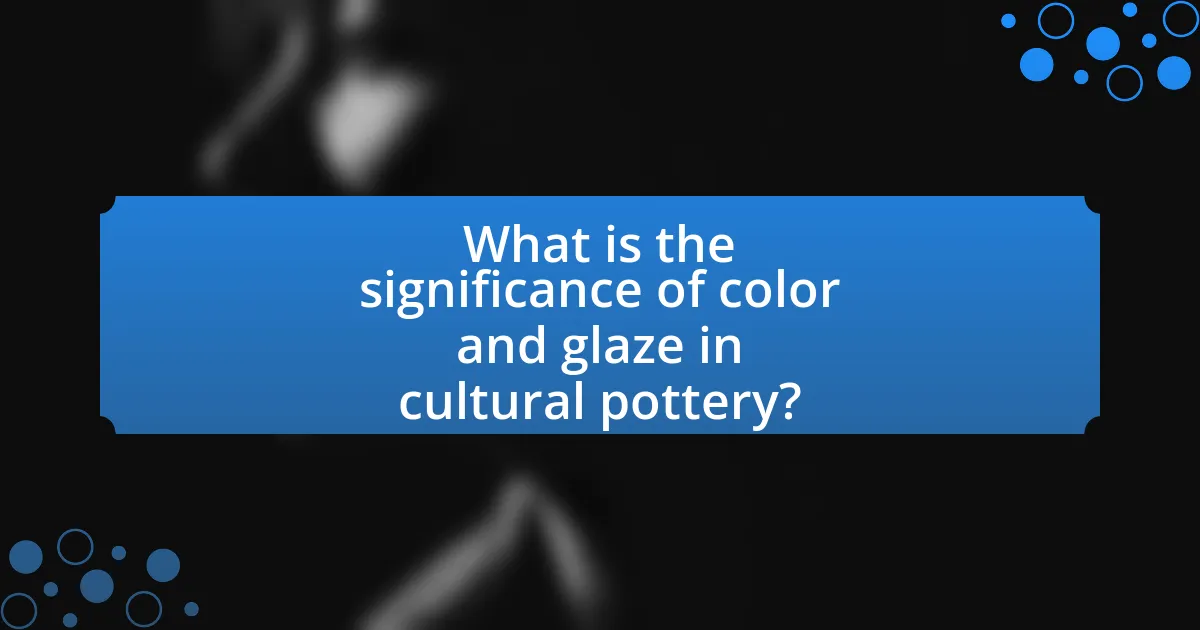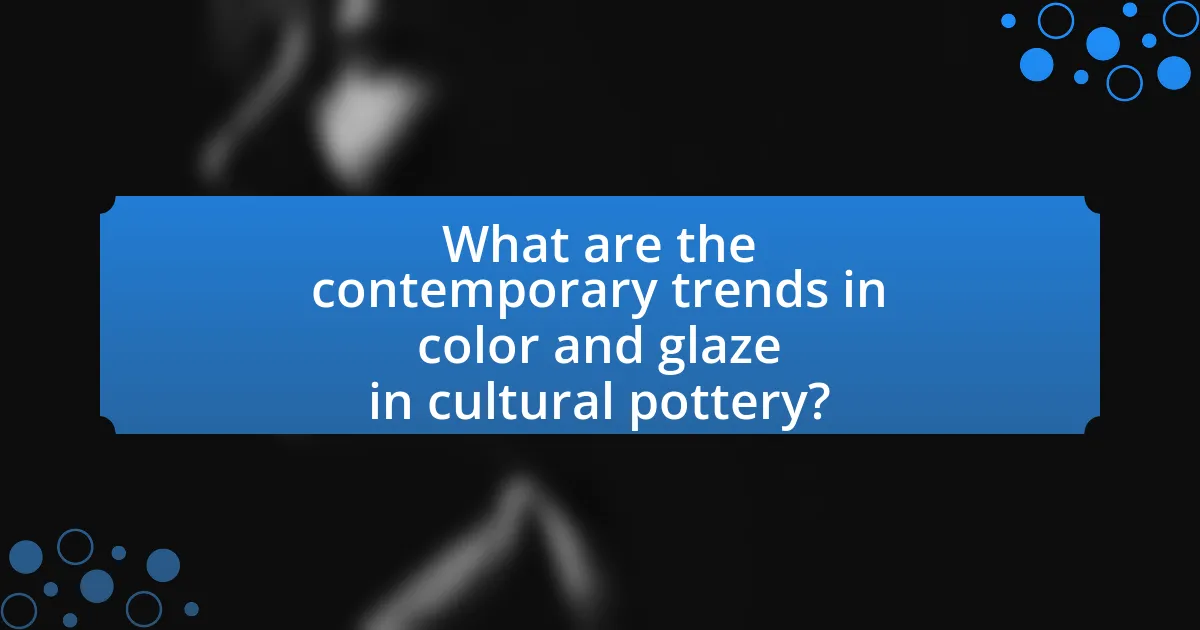The article examines the significance of color and glaze in cultural pottery, highlighting their roles in conveying meaning, identity, and aesthetic value across different cultures. It discusses how specific colors and glazing techniques symbolize beliefs, social status, and regional identity, with examples from Chinese porcelain and Mexican Talavera pottery. The article also explores the influence of color on aesthetic appeal, cultural symbolism, and the historical factors that shape color choices. Additionally, it addresses the techniques used in applying color and glaze, the impact of local materials, and contemporary trends in pottery, emphasizing the balance between tradition and innovation.

What is the significance of color and glaze in cultural pottery?
Color and glaze in cultural pottery serve as vital elements that convey meaning, identity, and aesthetic value. Different cultures utilize specific colors and glazing techniques to symbolize beliefs, social status, and regional identity; for example, the blue and white porcelain of China represents purity and elegance, while the vibrant colors of Mexican Talavera pottery reflect indigenous heritage and craftsmanship. Historical evidence shows that the choice of color and glaze can also indicate the technological advancements of a culture, as seen in the development of lead glazes in ancient Mesopotamia, which enhanced the visual appeal and durability of pottery. Thus, color and glaze are not merely decorative but are deeply intertwined with cultural expression and historical significance.
How do color and glaze influence the aesthetic appeal of pottery?
Color and glaze significantly enhance the aesthetic appeal of pottery by affecting visual perception and emotional response. The choice of color can evoke specific feelings; for instance, warm colors like red and orange can create a sense of warmth and energy, while cool colors like blue and green often convey calmness and tranquility. Glazes add depth and texture, influencing how light interacts with the surface, which can create visual interest and complexity. For example, a glossy glaze can reflect light, making colors appear more vibrant, while a matte finish can provide a softer, more subdued look. Historical evidence shows that different cultures have utilized specific colors and glazes to convey meaning and identity, such as the use of cobalt blue in Chinese porcelain, which symbolizes purity and elegance. Thus, the interplay of color and glaze is crucial in defining the overall aesthetic and cultural significance of pottery.
What role does color play in the cultural symbolism of pottery?
Color plays a crucial role in the cultural symbolism of pottery by conveying specific meanings and emotions associated with different hues. For instance, in many cultures, red symbolizes fertility and life, while blue often represents tranquility and spirituality. The use of color in pottery is not arbitrary; it is deeply rooted in cultural traditions and historical contexts. For example, the vibrant colors of Mexican pottery reflect indigenous beliefs and practices, where each color is imbued with significance, such as green representing nature and growth. This cultural symbolism is reinforced by the historical use of natural pigments, which were chosen for their meanings and availability, thus linking the pottery to the identity and values of the community that created it.
How does glaze affect the texture and finish of pottery?
Glaze significantly influences the texture and finish of pottery by creating a smooth, glossy surface or a matte finish, depending on its composition and application. The type of glaze used can enhance or alter the tactile quality of the pottery, with some glazes adding a reflective sheen while others provide a more subdued, textured appearance. For instance, high-gloss glazes can make surfaces feel slick and polished, while matte glazes can impart a soft, velvety texture. Additionally, the firing temperature and the interaction between the glaze and the clay body during the firing process can further modify the final texture and finish, resulting in unique visual and tactile characteristics that are essential in cultural pottery.
Why are specific colors chosen in different cultures?
Specific colors are chosen in different cultures due to their symbolic meanings and associations that resonate with cultural beliefs and practices. For instance, in many Western cultures, white symbolizes purity and is often used in weddings, while in some Eastern cultures, it represents mourning and is worn at funerals. This divergence illustrates how cultural context shapes the interpretation of color. Additionally, historical factors, such as the availability of natural pigments and materials, influence color choices in pottery. For example, the use of cobalt blue in Chinese porcelain reflects both the trade of materials and the cultural significance of the color, which is associated with immortality and spirituality. Thus, the selection of colors in cultural pottery is deeply rooted in symbolic meanings, historical context, and cultural practices.
What historical factors influence color choices in pottery?
Historical factors that influence color choices in pottery include the availability of natural pigments, cultural symbolism, and technological advancements in glazing techniques. For instance, ancient civilizations often relied on locally sourced minerals and plants for pigments, which dictated the color palette available to them. The use of iron oxide produced reds and browns, while copper compounds yielded greens and blues, as seen in ancient Chinese and Middle Eastern pottery. Additionally, cultural beliefs and practices shaped color significance; for example, certain colors were associated with specific deities or rituals, influencing artisans’ choices. Technological innovations, such as the development of high-temperature kilns, expanded the range of colors achievable, allowing for more vibrant and diverse pottery styles, as evidenced by the evolution of glazes in European ceramics during the Renaissance.
How do cultural beliefs shape the use of color in pottery?
Cultural beliefs significantly influence the use of color in pottery by dictating the meanings and associations attributed to specific colors within a society. For instance, in many Indigenous cultures, colors like red may symbolize life and vitality, while black can represent the earth or the afterlife. This is evident in the pottery of the Pueblo peoples of the American Southwest, where colors are chosen based on their spiritual significance and connection to nature. Additionally, in Chinese pottery, the color blue is often associated with immortality and is used in pieces intended for ceremonial purposes. Such cultural contexts demonstrate that the selection of colors in pottery is not arbitrary but deeply rooted in the values, traditions, and beliefs of the community, shaping both aesthetic choices and functional uses.
What techniques are used to apply color and glaze in pottery?
Techniques used to apply color and glaze in pottery include brushing, dipping, pouring, and spraying. Brushing involves applying glaze with a brush for detailed designs, while dipping submerges the pottery piece into a glaze solution for an even coat. Pouring allows for creative patterns by pouring glaze over the surface, and spraying uses an airbrush for a fine mist application, enabling intricate designs. Each technique affects the final appearance and texture of the pottery, demonstrating the versatility and artistic expression in ceramic art.
What are the traditional methods of glazing pottery?
Traditional methods of glazing pottery include dipping, brushing, and pouring. Dipping involves submerging the pottery piece into a glaze solution, ensuring an even coating. Brushing applies glaze with a brush, allowing for detailed designs and patterns. Pouring involves pouring glaze over the pottery, which can create unique effects as the glaze flows and settles. These methods have been used for centuries across various cultures, with historical evidence showing their application in ancient civilizations such as the Chinese and Greeks, where specific techniques were developed to enhance both functionality and aesthetic appeal.
How do modern techniques differ from traditional glazing methods?
Modern glazing techniques differ from traditional methods primarily in their use of advanced materials and technology, which enhance durability and aesthetic appeal. Traditional glazing often relied on natural materials and simpler firing processes, resulting in limited color palettes and less consistent finishes. In contrast, modern techniques utilize synthetic glazes and precise temperature control during firing, allowing for a broader range of colors and effects, such as glossy or matte finishes. Additionally, modern methods often incorporate digital technology for design application, enabling intricate patterns and designs that were difficult to achieve with traditional hand-painting techniques. This evolution reflects a significant shift in both artistic expression and functional performance in pottery.

How does color and glaze reflect cultural identity in pottery?
Color and glaze in pottery serve as vital expressions of cultural identity by embodying the aesthetic values, traditions, and historical narratives of specific communities. Different cultures utilize distinct color palettes and glazing techniques that are often rooted in local materials, spiritual beliefs, and social practices. For instance, the vibrant blue and white ceramics of the Ming Dynasty in China reflect not only artistic preferences but also the influence of trade and cultural exchange during that period. Similarly, Native American pottery often features earthy tones and intricate designs that symbolize their connection to nature and ancestral heritage. These choices in color and glaze are not arbitrary; they convey messages about identity, community values, and historical context, making them essential elements in understanding the cultural significance of pottery.
In what ways do color and glaze convey cultural narratives?
Color and glaze convey cultural narratives by symbolizing specific meanings and reflecting historical contexts within pottery. For instance, in many Indigenous cultures, certain colors are associated with spiritual beliefs or natural elements; red may symbolize life or fertility, while black can represent the earth or ancestors. Additionally, the techniques used in glazing, such as celadon in Chinese pottery, not only showcase aesthetic preferences but also indicate trade routes and cultural exchanges. Historical artifacts, like the vibrant blue and white porcelain from the Ming Dynasty, illustrate how color and glaze can narrate stories of cultural identity and technological advancement. Thus, the interplay of color and glaze serves as a visual language that communicates the values, beliefs, and histories of different cultures.
What stories are told through the colors used in pottery?
The colors used in pottery convey cultural narratives, beliefs, and historical contexts of the societies that create them. For instance, red often symbolizes life and fertility in many Indigenous cultures, while blue can represent spirituality or the sky in various Asian traditions. Specific color choices can also reflect local resources, such as the use of ochre for earthy tones or cobalt for vibrant blues, indicating the geographical and environmental influences on the pottery. Additionally, the symbolism of colors can vary significantly across cultures; for example, white may signify purity in some cultures, while in others, it may represent mourning. This diversity in color usage illustrates the rich tapestry of human experience and cultural identity embedded in pottery.
How does glaze contribute to the storytelling aspect of pottery?
Glaze contributes to the storytelling aspect of pottery by enhancing visual narratives through color, texture, and finish. Different glazes can evoke specific emotions or represent cultural symbols, allowing the potter to communicate themes, traditions, or personal stories. For instance, in ancient Chinese pottery, the use of celadon glaze not only provided a distinctive aesthetic but also symbolized purity and tranquility, reflecting the values of the society. Additionally, the layering of glazes can create depth and complexity, further enriching the narrative embedded in the piece. This interplay between glaze and form allows viewers to engage with the pottery on a deeper level, interpreting the stories conveyed through its surface.
How do regional differences affect the use of color and glaze?
Regional differences significantly influence the use of color and glaze in pottery, as these variations reflect local materials, cultural symbolism, and historical practices. For instance, in East Asian pottery, vibrant glazes like celadon and cobalt blue are prevalent, stemming from the region’s rich mineral resources and aesthetic traditions that emphasize harmony and nature. Conversely, Mediterranean pottery often features earthy tones and simple glazes, which are derived from locally sourced clays and reflect the region’s utilitarian approach to ceramics. Historical trade routes also played a role; for example, the introduction of new glazing techniques from the Middle East to Europe during the Renaissance led to the adoption of bright colors and intricate designs in European pottery. Thus, the interplay of local resources, cultural significance, and historical context shapes the distinct color and glaze practices observed in different regions.
What are the distinctive color palettes of various pottery traditions?
Distinctive color palettes in various pottery traditions include the earthy tones of Native American pottery, characterized by reds, browns, and blacks; the vibrant blues and whites of Delftware from the Netherlands; the rich, deep colors of Chinese Ming dynasty porcelain, often featuring cobalt blue and underglaze red; and the bright, bold colors of Mexican Talavera pottery, which typically showcases yellows, greens, and oranges. Each tradition reflects cultural significance and local materials, such as the use of natural pigments in Native American pottery and the cobalt sourced from Persia for Chinese porcelain, demonstrating the interplay between geography and artistic expression.
How do local materials influence glaze choices in pottery?
Local materials significantly influence glaze choices in pottery by determining the availability and characteristics of the raw materials used in glaze formulation. Potters often select glazes based on locally sourced minerals, such as clay, feldspar, and oxides, which affect the color, texture, and finish of the glaze. For example, iron oxide found in local soils can produce earthy tones, while copper from nearby deposits can yield vibrant greens and blues. This reliance on local materials not only shapes the aesthetic qualities of the pottery but also reflects the cultural identity and traditions of the region, as seen in various pottery styles worldwide that utilize indigenous resources.

What are the contemporary trends in color and glaze in cultural pottery?
Contemporary trends in color and glaze in cultural pottery emphasize vibrant hues, sustainable materials, and innovative glazing techniques. Artists increasingly utilize bold colors, often inspired by nature and cultural symbolism, to create visually striking pieces. Additionally, there is a growing focus on eco-friendly glazes made from natural minerals and organic materials, reflecting a commitment to sustainability. Techniques such as layering glazes and experimenting with textures are also prevalent, allowing for unique finishes that enhance the aesthetic appeal of pottery. These trends are supported by a resurgence in traditional methods combined with modern aesthetics, showcasing the dynamic evolution of cultural pottery.
How are artists innovating with color and glaze today?
Artists are innovating with color and glaze today by incorporating advanced technologies and sustainable materials into their practices. For instance, the use of digital tools allows artists to create intricate designs and experiment with color combinations that were previously difficult to achieve. Additionally, many artists are exploring eco-friendly glazes made from natural minerals and organic materials, which not only enhance the aesthetic quality of their work but also reduce environmental impact. This shift towards sustainability is evidenced by the increasing popularity of glazes derived from local resources, reflecting a growing trend in the pottery community to connect art with ecological responsibility.
What new materials are being used in glazing processes?
New materials being used in glazing processes include nanomaterials, such as silica nanoparticles, and advanced ceramic pigments. These materials enhance the durability and aesthetic qualities of glazes. For instance, silica nanoparticles improve the mechanical strength and thermal stability of glazes, while advanced ceramic pigments provide a wider range of vibrant colors and better lightfastness compared to traditional pigments. Research has shown that incorporating these materials can lead to glazes that are not only visually appealing but also more resilient to environmental factors, thereby extending the lifespan of cultural pottery.
How do contemporary artists balance tradition and innovation in color use?
Contemporary artists balance tradition and innovation in color use by integrating historical color palettes and techniques with modern materials and concepts. For instance, many artists draw inspiration from traditional glazing methods, such as those used in ancient pottery, while experimenting with contemporary synthetic pigments that offer a broader range of colors and finishes. This approach allows them to honor cultural heritage while pushing the boundaries of artistic expression. Evidence of this balance can be seen in the works of artists like Grayson Perry, who incorporates traditional ceramic techniques with modern themes, demonstrating how historical practices can coexist with innovative ideas in color application.
What challenges do potters face regarding color and glaze?
Potters face several challenges regarding color and glaze, primarily related to achieving consistency and desired effects during the firing process. Variations in kiln temperature, atmosphere, and the chemical composition of glazes can lead to unexpected results, such as color changes or defects. For instance, a glaze that appears one color before firing may turn entirely different due to reactions with the clay body or changes in oxidation levels. Additionally, sourcing reliable materials for pigments and glazes can be difficult, as some natural materials may vary in quality or availability, impacting the final outcome. These challenges necessitate a deep understanding of materials and firing techniques to achieve the intended aesthetic and functional qualities in pottery.
How do environmental factors impact the glazing process?
Environmental factors significantly impact the glazing process by influencing the temperature, humidity, and atmospheric conditions during firing. High temperatures are essential for achieving the desired chemical reactions in glazes, while humidity can affect the drying time of the pottery before firing. For instance, a study published in the Journal of Ceramic Science and Technology indicates that variations in kiln atmosphere, such as oxidation or reduction conditions, can alter the color and texture of the glaze, demonstrating that environmental conditions directly affect the final appearance of the pottery.
What are common issues encountered with color consistency in pottery?
Common issues encountered with color consistency in pottery include variations in glaze application, firing temperature fluctuations, and differences in clay body composition. Variations in glaze application can lead to uneven color distribution, as inconsistent thickness can affect how the glaze interacts with the clay during firing. Firing temperature fluctuations can cause colors to change or develop differently, as certain pigments react sensitively to temperature changes. Additionally, differences in clay body composition, such as iron content or mineral variations, can influence the final color outcome, leading to inconsistencies across pieces. These factors collectively contribute to challenges in achieving uniform color in pottery.
What best practices can enhance the use of color and glaze in pottery?
To enhance the use of color and glaze in pottery, potters should focus on understanding the chemistry of glazes, experimenting with layering techniques, and applying consistent firing practices. Understanding glaze chemistry allows potters to predict how colors will react during firing, leading to more successful outcomes. Layering different glazes can create unique visual effects and depth, as seen in techniques like “shino” or “tenmoku,” which are traditional Japanese styles known for their rich colors and textures. Consistent firing practices, including temperature control and atmosphere management, are crucial, as variations can significantly alter the final appearance of the glaze. These best practices are supported by historical examples, such as the vibrant glazes of ancient Chinese pottery, which resulted from meticulous experimentation and understanding of materials.


